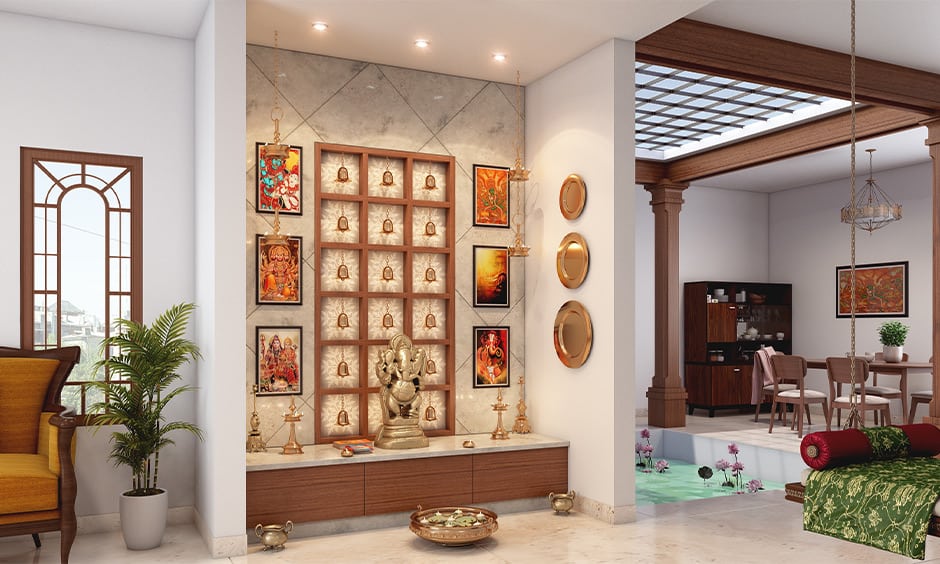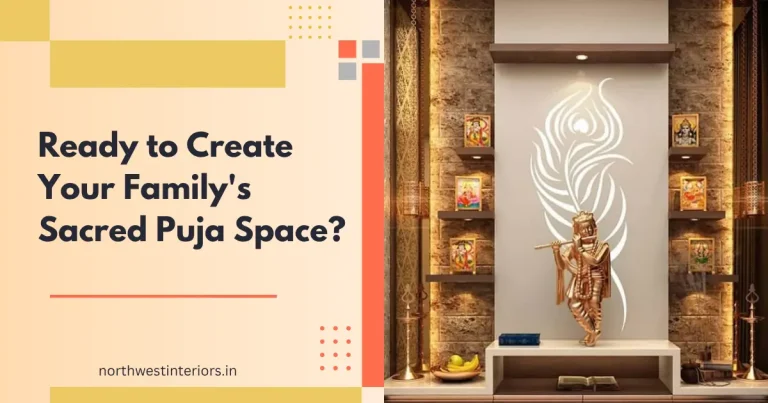Creating a sacred puja room goes beyond aesthetics—it’s about establishing a spiritually harmonious space that facilitates devotion and brings peace to your home. Whether you’re designing a dedicated room or a compact corner, certain essential elements transform any space into a divine sanctuary.
1. Vastu-Compliant Direction and Placement
Direction is fundamental in puja room design. According to Vastu Shastra, the ideal directions are:
- Northeast (Ishanya): Most auspicious, brings prosperity and positive energy
- East: Second-best option, welcomes morning sunlight and divine blessings
- North: Acceptable alternative, associated with wealth and abundance
- West: Suitable when other directions aren’t feasible
The deity placement should face either east or west, ensuring worshippers face the auspicious directions during prayers. Avoid south-facing placements as they’re considered inauspicious in traditional beliefs.
2. Elevated Platform or Mandir Structure
The sacred platform elevates deities to a position of honour. Traditional wisdom suggests the platform height should be at chest level when seated, typically 18-24 inches from the floor.
Material choices include:
- Solid wood (teak, rosewood) for traditional aesthetics
- Marble for durability and easy maintenance
- Granite for modern, sophisticated looks
- Engineered wood with laminate for budget-friendly options
The platform should have sufficient depth (minimum 12-15 inches) to comfortably accommodate idols, lamps, and offerings.
3. Proper Lighting Design
Lighting creates ambience and serves functional purposes. A well-lit puja room interior combines:
Natural Light: Position near windows when possible, allowing morning sunlight to illuminate the space—considered highly auspicious.
Artificial Lighting: Layer different types:
- Ambient lighting for overall illumination
- Accent lights highlighting the deity (LED strips, spotlights)
- Traditional diyas and lamps for ritual purposes
- Dimmable options to create a peaceful meditation atmosphere
4. Adequate Ventilation and Fresh Air
Proper air circulation maintains a fresh and pleasant environment, essential for daily worship. Cross-ventilation through windows or exhaust fans prevents stuffiness and effectively removes incense smoke.
Good ventilation also protects wooden elements from moisture damage and prevents mould growth, especially in humid climates like Tamil Nadu.
5. Organized Storage Solutions
Clutter-free spaces enhance spiritual focus. Essential storage includes:
- Enclosed cabinets for puja essentials (incense, camphor, oil)
- Drawer systems for sacred texts and prayer accessories
- Display shelves for additional deity idols and religious artefacts
- Hidden compartments for valuable items like silver lamps
Well-organized storage ensures everything has its place, maintaining the room’s sacred cleanliness effortlessly.

6. Sacred Bells and Sound Elements
Traditional brass bells are essential—their sound purifies the environment and marks the beginning of rituals. Consider installing a permanent bell arrangement with a proper hanging mechanism, rather than placing loose bells that can topple over.
Some families also incorporate conch shells and small musical instruments used during aartis and bhajans.
7. Threshold and Entrance Design
The puja room entrance should be distinct and respectful. Essential elements include:
- Raised threshold (2-3 inches) to prevent casual entry
- Decorative door frame with traditional motifs
- Brass or wooden doors with religious symbols
- Threshold decoration (kolam/rangoli space)
A proper entrance creates a psychological transition from mundane to sacred space.
8. Appropriate Flooring
Easy-to-clean, non-slippery flooring is practical and safe. Popular choices:
- Marble or granite: Cool, clean, traditional
- Ceramic tiles: Affordable, variety of designs
- Wooden flooring: Warm, comfortable for longer prayers
Ensure the flooring allows for comfortable sitting for extended periods and can be easily cleaned after use with an oil lamp.
9. Colour Palette and Wall Treatment
Calming colours enhance a meditative atmosphere. Traditional favourites include:
- White: Purity and peace
- Light yellow: Auspiciousness and positivity
- Soft orange: Devotion and energy
- Light blue: Serenity and divine connection
Avoid dark, aggressive colours that create a heavy, oppressive energy. Simple, clean walls with subtle traditional borders are more effective than busy patterns.
10. Personal Spiritual Elements
Finally, incorporate family traditions and personal devotional items:
- Sacred texts and religious books
- Family deity heirlooms
- Prayer beads (mala)
- Holy water vessels (kalash)
- Offering plates and accessories
Creating Your Perfect Sacred Space
A well-designed puja room strikes a balance between spiritual requirements, practical functionality, and aesthetic appeal. Every element should contribute to creating an environment that encourages daily worship and brings peace to your family.
When planning your puja room, consider consulting with designers who understand both Vastu principles and modern home constraints. Northwest Interiors specializes in creating spiritually aligned, beautifully crafted puja rooms that honour tradition while fitting seamlessly into contemporary homes across Chennai, Madurai, Trichy, and Coimbatore.
A thoughtfully designed puja room becomes the spiritual heart of your home, offering a sanctuary for daily devotion and family blessings for generations to come.

